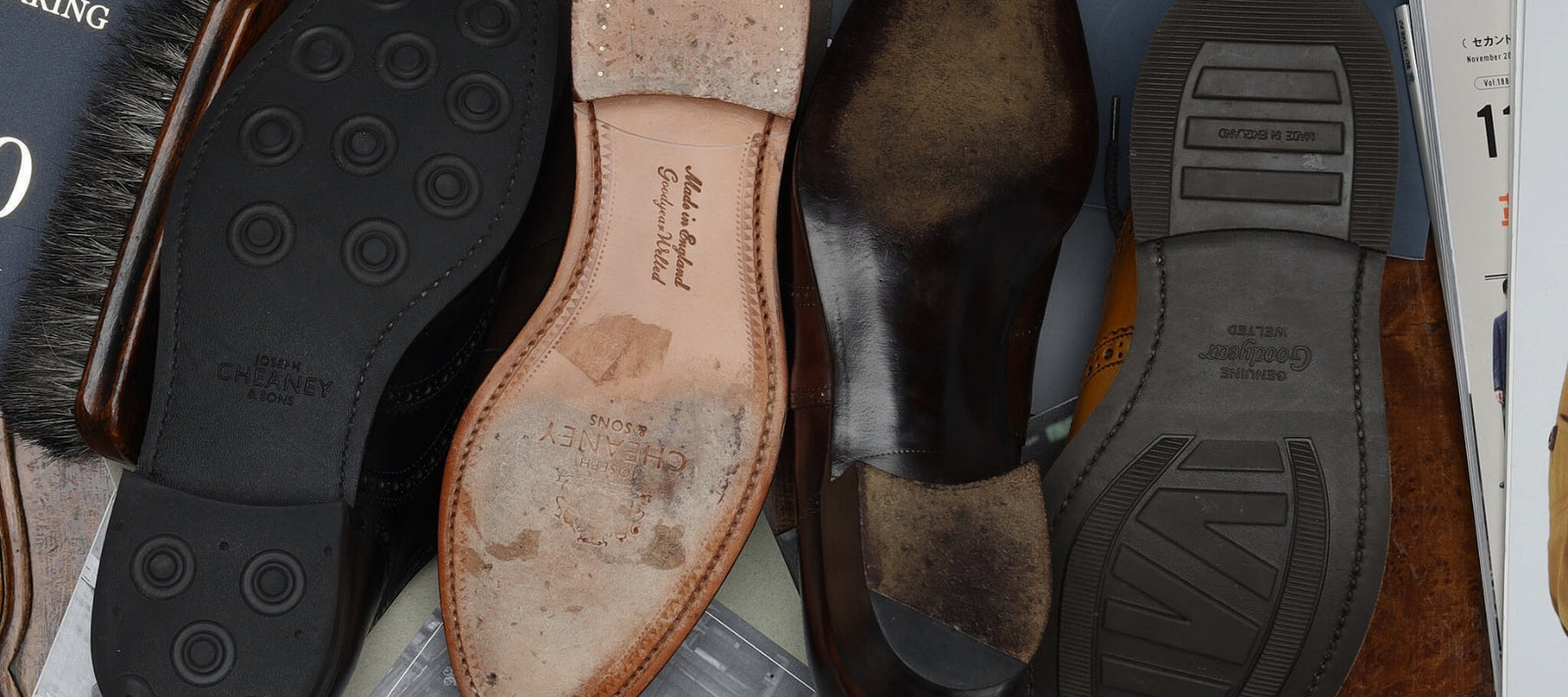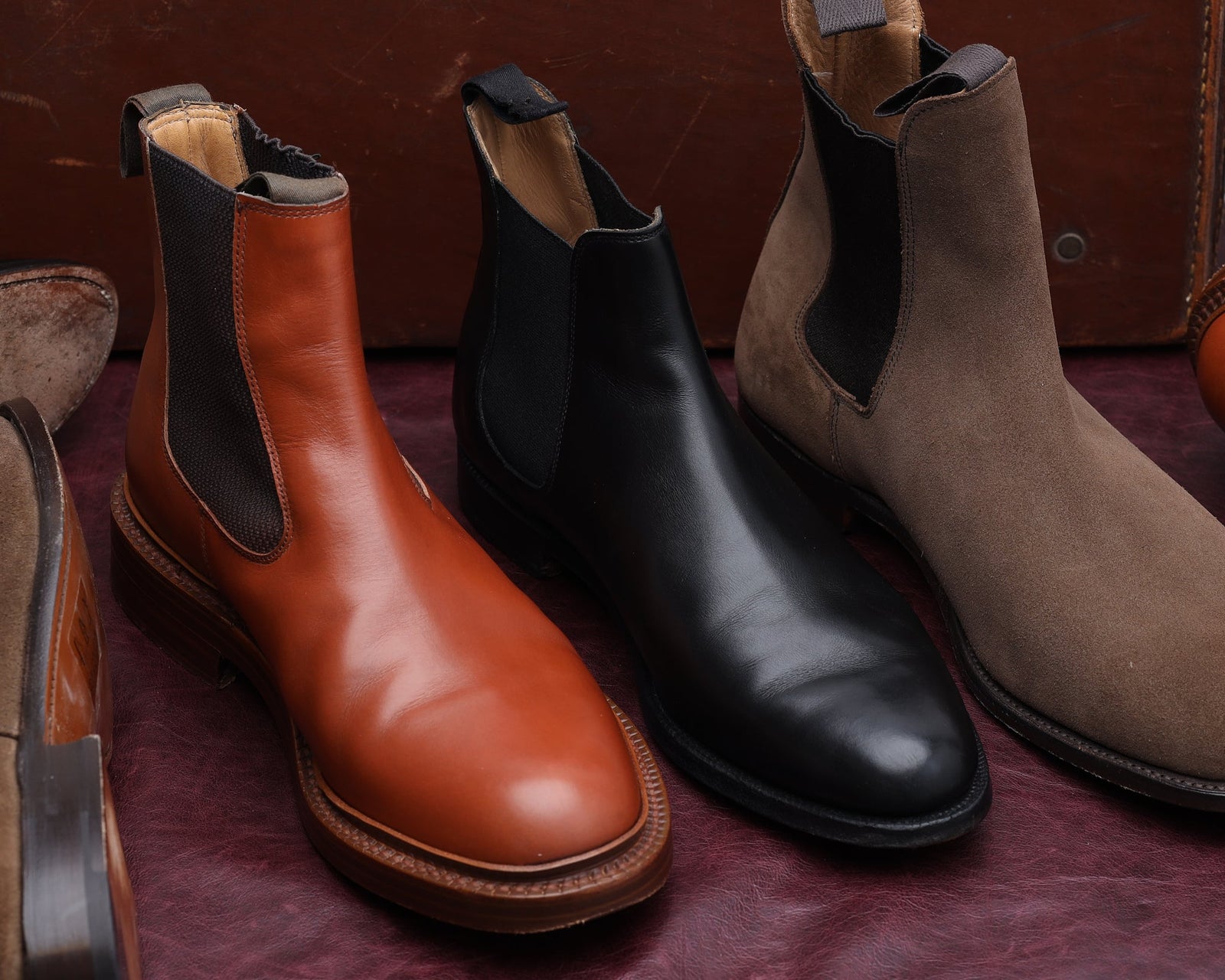Welcome back to The Abbot’s Edit. In this edition, we turn our attention to what lies beneath. From traditional leather to modern sustainable rubber compounds, the sole defines comfort, durability, and style. Choosing the correct type for your purpose is key to making an investment-worthy purchase — so read on as we tread carefully through the pros and cons of each.
Finding your Footing: Materials
Leather Soles
For centuries, the full leather sole has been the hallmark of craftsmanship and sophistication. Timeless in style and unmatched in feel, a well-made leather sole embodies luxury with every step.
-
The Appeal: Bench-grade leather soles are remarkably breathable, allowing moisture to escape and molding to your foot’s unique shape over time. The result is a custom fit and a distinctive, refined comfort that only improves with wear.
Rubber Soles
When the weather turns wet or the terrain gets tough, a high-quality rubber sole is your reliable companion. Built for traction, durability, and practicality, rubber soles excel in challenging conditions while maintaining a refined appearance.
- The Appeal: From the sleek, studded Dainite sole to the rugged, deep-lugged Commando design, rubber soles provide superior grip, water resistance, and long-lasting comfort. They deliver confident footing in any environment — whether you’re navigating city streets, country trails, or winter weather.
Crepe Soles
A beautiful balance of form and function, the crepe sole brings a distinctive look and an exceptionally comfortable feel. Its natural resilience and flexibility make it a favorite for relaxed, everyday wear.
- The Appeal: Made from layers of raw, natural rubber, crepe soles are soft, flexible, and shock-absorbent — offering unmatched comfort for casual days and effortless style.
EVA Soles
Lightweight, resilient, and designed for all-day ease, EVA (Ethylene Vinyl Acetate) soles represent the evolution of modern footwear comfort. They combine both performance and style.
- The Appeal: Known for their exceptional cushioning and shock absorption, EVA soles deliver cloud-like comfort without excess weight. They are water-resistant, flexible, and remarkably durable — making them ideal for both leisure and travel. Whether in sneakers, loafers, or hybrid dress shoes, EVA soles bring contemporary comfort to classic design.
Type |
Pros |
Cons |
Ideal Use |
Example |
| Leather |
|
|
|
John Lobb 'Jermyn II' Monk Strap |
| Rubber |
|
|
|
Tricker's 'Stow' Boots |
| Crepe / Natural Rubber |
|
|
|
Astorflex 'Greenflex' Chukka Boots |
| EVA |
|
|
|
Church's 'Fulbeck' Derby |
The Craft Behind the Comfort: Makers & Tanners
When discussing high-quality materials, the source is paramount.
Leather Tanneries:
The finest leather soles originate from heritage tanneries where tradition and innovation meet.
John Rendenbach (JR), now produced at the Kilger Tannery: Revered for its oak-bark tanning process that can take up to a year, JR leather is known for its dense fiber structure, natural resilience, and remarkable resistance to moisture and wear. The Kilger Tannery continues this legacy with the same meticulous, time-honored craftsmanship.
J.&F.J. Baker: The last remaining oak-bark tannery in Britain, Baker’s leather is prized for its supple strength and deep, rich finish. Each hide spends up to 12 months in oak bark liquor, developing a characterful patina and durability unmatched by modern chemical methods.
Together, these tanneries set the global standard for bench-grade leather soles — sustainable, breathable, and built to last.
Dainite:
A signature of British shoemaking, Dainite soles from the Harboro Rubber Co. deliver the perfect blend of formality and function — clean lines, superb grip, and longevity. A staple for premium Goodyear Welted footwear.
Vibram:
The Italian titan of traction, Vibram produces a vast range of highly durable rubber compounds. From alpine-ready lugs to sleek urban treads, a Vibram sole guarantees world-class grip, performance, and durability.
Stitched for Success: Construction Methods
A sole is only as strong as the method by which it’s attached. Construction dictates not only a shoe’s durability but also its flexibility, comfort, and ability to be easily repaired.
Goodyear Welt:
The hallmark of heritage shoemaking. This method involves stitching a leather welt to both the upper and the insole, then attaching the sole to that welt. The result? Unmatched durability, structure, and — crucially — ease of resoling. Ideal for premium footwear designed to last decades.
Blake Stitch:
A sleeker, lighter alternative where the sole is stitched directly to the insole and upper. This creates a more flexible, close-cut silhouette but makes waterproofing and resoling more complex. Perfect for refined dress shoes where elegance takes priority.
Blake-Rapid:
A hybrid method that adds an additional midsole layer to the Blake construction for increased strength and weather resistance — the sweet spot between comfort and resilience.
Storm Welt:
A Goodyear variant with an additional folded welt that wraps the upper edge, providing superior water resistance. A favourite for country and winter boots.
Closed Channel Stitching:
A hallmark of craftsmanship, this method hides the outsole stitching within a finely cut channel, leaving a perfectly smooth and refined finish.
The Final Step
Every sole tells a story of craftsmanship, material mastery, and personal journey. Whether you’re striding through city streets or countryside paths, understanding what lies beneath your feet transforms how you experience your footwear.
From the finest oak-bark-tanned leather to the enduring grip of a Dainite studded sole, explore our collection of premium quality footwear — each crafted using world renowned construction methods and materials.




